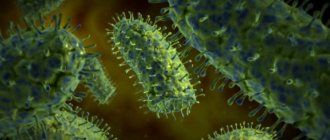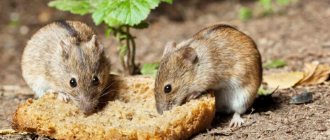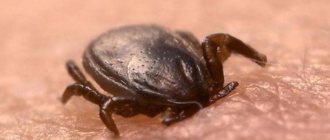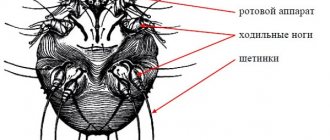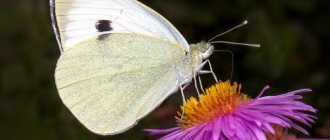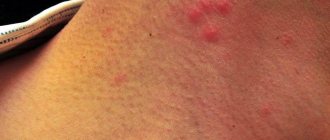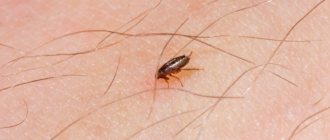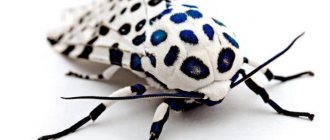Main routes of infection by head lice
The main route of infection is through household contact. Most often it is close contact with another person that occurs when hair touches. Since lice move very quickly, it only takes a few seconds for them to move from another person and settle on the scalp.
There are other ways you can become infected with lice, although the likelihood of such infection is low:
- • using other people's combs, hairpins, hair decorations;
- • hats;
- • staying on public transport during rush hour;
- • poorly processed accessories in hairdressing salons
- • pillowcases on the pillows of an infected patient.
Causes of nits
Nits appear only after an adult louse moves to an area of the human body (head, groin, armpits). Relocation can occur as a result of contact, use of things of an infected person, etc.
After infection, one female lays at least 5 eggs per day. In a month, an insect that reaches only 4 mm in length brings up to two hundred eggs, and this is not the limit. Eggs mature in 5-7 days; After hatching, the larvae become capable of reproduction within a week, and the number of nits increases several times.
How they appear
Nits appear in two cases. The first is when the female louse jumps from one host to another during close contact. And the second is when a healthy person uses a comb (hat, hair tie, hair clip) of an infected person. In the latter case, only a small part of the nits gets stuck on the hair on the head.
What they look like
All nits are covered with a sticky membrane. They are capsules attached to the hair thanks to glue and a tail, which acts as a retainer.
To help those who are faced with an unpleasant phenomenon, there are several differences between dandruff and nits:
- Dandruff is easier to remove with a regular comb because it glides along the entire length of the hair. Unlike nits, which are held on the hair surface by an adhesive membrane.
- The shape of nits is smooth and round, dandruff is irregular and heterogeneous. Nits are the same size compared to dandruff.
- Nits cannot fall on the collar and shoulders of clothing, like dandruff. They leave the head only with the hair.
- Dandruff causes mild irritation, lice causes severe itching.
- Lice lay eggs in 3 places: on the frontal lobe, on the back of the head and on the temples. Dandruff appears mainly on the top of the head.
- Dandruff does not make a dry clicking sound when pressed.
In addition, dandruff is easier to remove than lice.
Causes of lice
The problem under consideration is very relevant, because these parasites, as a rule, appear suddenly.
In fact, despite numerous myths, it is necessary to understand the main thing - lice are external parasites, and only humans can be their carrier.
Lice feed on human blood, while the “owner” himself constantly suffers from discomfort, manifested in the form of itching and pain in the affected areas.
By the way, lice can be of several types:
- pubic; pubic lice
- head louse
- body lice. Linen lice (body lice)
And if we look deeper into the problem of head lice, we can identify several main reasons.
Table. Where do lice come from?
| Public places | These are potential risk areas. A striking example would be, say, child care institutions. Children often become infected with head lice in kindergartens and schools. |
| Water | Yes, water can indeed act as a source of infection, since lice can live in it for some time. That is why it is quite possible to pick up parasites in a body of water with stagnant water, not only in a pool, but also in a rural lake. |
| Close contact | As noted above, lice can be transmitted through human interaction. This could be, for example, kissing or sexual intercourse (more relevant to pubic parasites), group games (mainly childhood infections). |
| Neglect of hygiene rules | Parasites are more often acquired by those who neglect personal hygiene and live in unsanitary conditions. |
| Long journey | The risk of infection in such cases increases. And the point here is not only that there is not always access to the simplest hygiene procedures, but also that on the road you have to come into contact with a large number of people, including carriers of lice. |
| People living together | This applies to places where large numbers of people live (summer camps, prisons, etc.). |
| Personal belongings of the bearer | Towels, combs and other items of a carrier that contain lice or nits can also be contagious. Few people know that these parasites can live without air for up to 24 hours. |
https://www.youtube.com/watch?v=oDiNUzOWk5c
Important information! According to statistics, lice most often become infected in the autumn and winter, when people spend most of their time indoors, actively contacting each other.
But, in principle, pediculosis can appear under different circumstances. So, just standing next to the carrier on public transport is enough for the parasites to crawl onto the other person’s hair.
Yes, lice cannot jump like fleas, but they crawl quickly (about 4 mm/sec), and when they get on a new “host”, they begin to actively bite him and multiply.
The incubation period of pediculosis, by the way, takes about three weeks.
The main methods of infection with body lice
This type of parasite lives in the folds of clothing, bed linen, and mattresses. They move onto the human body to obtain food. The bites themselves are invisible, but cause severe itching with the formation of wounds after scratching.
Not only people leading an asocial lifestyle can suffer from body lice. The route of infection is through close contact with an infected person. The risk increases in crowded places: boarding schools, prisons, army barracks. Infection requires prolonged contact
Lice and personal hygiene: addiction
One of the most common misconceptions about lice is that only people who do not pay enough attention to personal hygiene become infected. Since infection occurs through close contact with another person, cleanliness of hair or body does not matter. The disease can occur even in the cleanest people.
Symptoms of the development of pediculosis in humans
If a person has developed pediculosis, the following symptoms may occur:
- Itching and discomfort at the bite sites.
- Excoriation, or, in simple terms, scratching.
- The presence of lice eggs, which are colloquially called nits.
- Small spots on the skin, gray-blue in color.
- Sometimes boils, ulcers and deep scars appear against the background of pediculosis.
- Rarely does a generalized allergy develop, which manifests itself in addition to skin rashes as headache, nausea and deterioration in general condition.
- If there are a lot of parasites on the body and head, then this affects a person’s well-being, causes various complications and can even lead to death.
ATTENTION! If a person constantly scratches the bites, then over time an infection can penetrate into the wounds, which leads to the formation of ulcers on the scalp.
Myths about lice infestation
Despite the fact that head lice is a well-studied disease, it is still associated with many misconceptions and myths. Let's look at the most common of them.
Lice can fly or jump over
This type of insect can neither fly nor jump, so they are transmitted only through close contact. By being at a distance with a person whose cleanliness you doubt, you can completely protect yourself from infection.
Lice can appear as a result of emotional shock
Parasites in the head area are the result of their transfer from another person. Infection does not occur due to a nervous breakdown, strong emotions, or in people weakened by illness if they have not been in contact with infected patients.
You can get rid of lice only by shaving or cutting your hair short.
For many years, when lice were found, boys' heads were shaved bald, and girls' hair was cut as much as possible. It was believed that only their absence would help quickly and reliably eliminate parasites.
Indeed, it is much easier to eliminate parasites on a head without hair. The most difficult task is to get rid of lice on long hair, which will have to be combed out very carefully. However, this does not mean that you cannot do without shaving and a short haircut. Modern means allow you to quickly get rid of unwanted insects in just one application without the need to use radical methods.
There is nothing more reliable than traditional methods
Lice have been known to man for many centuries. It is not surprising that during this time many ways to get rid of parasites have been found. But many of them are highly toxic and can be dangerous to humans, for example, causing scalp burns.
Modern remedies are much more effective and safer than folk remedies. They do not pose a risk of skin damage or poisoning, allergic reactions or other side effects.
You can get rid of lice using hair dye
Some chemicals that are part of hair dye can actually have a detrimental effect on parasites. But this does not mean that it is advisable to use them to get rid of lice. The effectiveness will be low, but there is a risk of damaging your hair.
Lice carry dangerous diseases
The parasites themselves are not carriers of dangerous diseases, in particular typhus. The risk of disease increases as a result of scratching the scalp, which creates wounds through which infection can penetrate. But in our time, infection with typhus is unlikely
Pediculosis is a disease of antisocial individuals
This is the main myth associated with lice infestation. Indeed, many people with low levels of cleanliness, such as homeless people or antisocial individuals, are affected by lice. But most of us rarely come into close contact with them.
When should you see a doctor?
Over the past decades, lice have developed resistance to the chemicals used to remove them. In rare cases, lice can transmit typhus or fever, but advanced cases can cause pyoderma and purulent skin lesions. To prevent this, at the first sign of lice detection, you need to contact your local physician.
Do you see a doctor if you are diagnosed with lice?
Not really
Complications of pediculosis:
- conjunctivitis;
- inflammation of the edges of the eyelids;
- inflammation of the lymph nodes;
- streptococcal infections;
- bacterial infection (pyoderma) of the face, behind-the-ear areas and scalp;
- typhus (rare).
The doctor will determine the type of lice parasitizing on humans and select the optimal treatment . In addition, the incubation period of head lice is a month. And being in a group with a large number of people can provoke an outbreak of head lice, since the symptoms are not immediately noticeable.
The louse, as an insect, is very interesting for scientists to study. But for people it poses a danger of contracting lice. To avoid illness, you need to regularly carry out hygiene procedures, not use other people’s hygiene items and regularly wash your bed linen. In this case, the risk of infection is reduced to zero. And you don’t have to study the insect on your comb; it’s better to leave this to the specialists.
- about the author
- VK profile
How to avoid infection
Unfortunately, there is no 100% protection against lice infestation. But if you follow certain precautions, you can significantly reduce the risk of infection:
- • keep your head and body clean;
- • avoid close contacts with unscrupulous people and teach children this;
- • avoid sleeping on other people's bedding, especially pillowcases;
- • keep your clothes clean to prevent infestation with body lice;
- • avoid casual relationships - in order to prevent infection with pubic parasites;
Parents of a child attending kindergarten or school should regularly examine the child's head, without waiting for symptoms of infection (itching and nits on the hair) to appear. Early detection of parasites will help get rid of them as soon as possible.
If parents find lice on their child, they should notify the teacher or educator. The infection occurred in a children's group, therefore, to prevent further spread of infection, it is necessary to identify the source of infection. If this is not done, the child may become infected again.
It is easier for lice to switch to long, flowing hair, so girls should give preference to neat hairstyles - ponytails or braids.
What do lice and nits look like on the head?
A nit and a louse are two stages of the development of one parasite, which differ from each other in many ways - from appearance to feeding methods.
- Nits: a creature contained in a capsule made of a sticky shell. It is thanks to this sticky secretion that the capsule is attached to the hair shaft. When examined under a microscope, you can notice a peculiar tail-attachment. It has a white-pearlescent sheen, and after hatching it dries and acquires a yellowish-gray tint, but still remains on the hair. Because of this, an illusion is created that the number of nits is many times greater than the number of adults.
- Louse: parasites with an elongated, flat, translucent body. Size from 3 to 4 mm, females are slightly larger than males. A hungry individual has a grayish-brown color. When full, it becomes saturated with blood and acquires a distinct scarlet color. In addition, after a meal, the parasite’s body increases significantly and takes on an almost round shape. Upon closer examination through a microscope, three pairs of limbs equipped with microclaws can be seen. On the head you can see antennae and simple eyes. The oral apparatus is much more complex. It consists of an opening around which there are sharp chitinous hooks, piercing needles and a tube through which blood flows into the insect’s intestines.
Folk remedies if infection does occur
If you find lice on yourself or your child, there is no need to be scared, much less make a tragedy out of it. Infection with parasites is unpleasant, but fighting them is quite possible. For this purpose, both pharmaceutical products and traditional methods are used.
Over the years, traditional medicine has accumulated many effective recipes that are traditionally used to get rid of unpleasant insects. Let us give examples of the most common and safest of them.
Combing
For this purpose, you need to use a special comb with fine teeth. This is a rather labor-intensive and time-consuming method. It involves thoroughly combing your hair strand by strand for 40-45 minutes. To enhance effectiveness, the comb is periodically moistened in vinegar.
The disadvantage of this method is that even with the most thorough combing, you can miss parasites, and even a small amount of them will provoke the disease again.
Vinegar
9% vinegar is dissolved in water in a ratio of 1:2 and the mixture is applied to the head, wrapped in plastic and a towel and left for 30-40 minutes. After this, wash your hair with regular shampoo and comb your hair with a comb to remove nits.
The disadvantage of this method is the risk of scalp burns.
Cranberry
Apply cranberry juice to your hair and wait half an hour. In an acidic environment, insects die, and nits peel off from hair more easily. This is a safe method, but not always effective enough.
Kerosene
Typically, a mixture of kerosene and a vegetable or soap solution was used to get rid of lice. The mixture is applied to the head for 1-1.5 hours, then rinsed off and washed with regular shampoo.
The kerosene-based mixture effectively removes parasites, but is highly toxic. It should be noted that there is a high risk of skin burns and negative effects on hair condition.
All home remedies can only be beneficial in the early stages of the disease, when the number of active individuals is small. But since lice are rarely found at this stage of infestation, more effective remedies should be sought for greater effectiveness.
Modern drugs against head lice are safe and reliable. They allow you to get rid of parasites quickly, reliably, without risk to health.
Life cycle
If the ambient temperature is comfortable, this classification of lice reproduces throughout the year. The life cycle of individuals is small and often does not exceed 46 days. During this time, a sexually mature female manages to lay about 100-120 (about 4 eggs per day). With the help of a sticky secretion, future offspring are securely attached to a person's hair. When exposed to air, it noticeably hardens and ensures better preservation of the egg’s contents.
Egg development lasts no more than 5 days. After this, larvae appear that are practically no different from adult individuals. They also feed on human blood and continue to grow actively for some time. They regularly shed their chitinous shell and each time they become larger in size. Reproductive organs gradually appear and the insect becomes sexually mature.
By the way, the entire process of maturation of young organisms directly depends on environmental conditions. At low temperatures, any stage can be suspended and drag on for many months. Lack of food will further aggravate the situation and may even contribute to the mass death of adults and their undeveloped young.
Effective treatment
A reliable and effective remedy for lice is the Paranit line of modern products. It allows you to get rid of parasites in just one application without the risk of side effects and allergic reactions.
A pediculicidal agent based on the active substance dimethicone and mineral oils blocks the respiratory tract of insects, which causes their death. “Paranit” is produced in the form of a spray, lotion, and shampoo. It belongs to the class of low-hazard compounds, so it can be used both for children (Paranit Sensitive from 1 year old) and for adults.
Advantages of the drug:
- • kills lice in 15 minutes;
- • non-addictive, repeated use is possible;
- • suitable for pregnant and lactating women - Paranit Sensitive is recommended;
- • does not harm hair;
After treating the head, rinse off the product and comb the hair with a comb, which is included in most forms. The product is very economical; one bottle is enough to remove lice from several people, so it can be recommended for family use.
Features of pediculosis
Subcutaneous lice in humans appear upon contact with contaminated objects or the skin of a sick person. The incubation period lasts about 2 weeks. But from the first days you can notice the symptoms of subcutaneous lice.
- Scabies begins with skin lesions between the fingers. An unbearable itching appears, which intensifies in the evening and progresses at night. At this time, the scabies mite is especially active.
- Bubbles filled with liquid appear on the affected area. After scratching, wounds remain and passages can be seen.
- As the disease progresses, the extent of damage to the body spreads. The pathological process involves the arms, legs, neck, abdomen, back, genitals, and face. Lice do not live under the scalp.
- The body is covered with a small rash, and large red blisters appear in some places. The manifestations on the buttocks are clearly visible.
- The skin in the affected areas becomes thicker, and swelling of the hands is observed.
Lack of measures leads to the addition of a secondary infection, complicating the situation.
Pediculosis is an unpleasant, but not very dangerous disease. You can catch it directly from the human breeder. To do this, you can use his comb, wear his headdress, or sleep next to him, on the same bed linen.
This is why children become infected more often than adults - they rarely adhere to safety measures, and games involve close physical contact. This disease is much less common in adolescents. Homeless people and drunkards are at risk. At the same time, subcutaneous lice are almost never found on the human head.
Our grandmothers used acetic acid, ash powder and even dust to treat pediculosis. Today there is no need to put your body in danger and apply a substance to your scalp that is potentially dangerous to your health. There are quite simple recommendations that will allow you to quickly remove parasitic insects.
- Use a thick comb to comb your head thoroughly. All removed insects must be destroyed.
- Dry your hair with a hairdryer (hot air) to destroy the parasite eggs.
- The pharmacy sells shampoos, ointments, sprays and aerosols - all of these products contain substances that are toxic to parasites, but safe for humans.
Body louse (Pediculus corporis) under a microscope
WHY DO LICE APPEAR ON YOUR HEAD?
Parasites and us. Do not watch for the faint of heart. Parasites are the cause of most diseases! How to cleanse...
The worst case of head lice
These two diseases can cause very similar symptoms. But the treatment will be different in each case.
Therefore, it is important to determine exactly what kind of problem we are talking about.
To begin with, it is worth noting that the scabies mite very rarely affects the hairline area. Pediculosis concentrates there. Scabies on the scalp extends no further than the ears and chin.
Differential diagnosis should be carried out by a specialist
The scabies mite prefers “secluded corners”. The parasite primarily affects the armpits, abdomen and buttocks, the space between the fingers and the genitals. In contrast, lice are mainly concentrated on the head, but can also affect the pubic area, which is covered with hair.
Markings on the skin with scabies and pediculosis will be completely different. During its life, the scabies mite leaves waste that causes an allergic reaction in humans. A rash will appear on the skin. Lice feed on blood and leave small wounds after biting.
